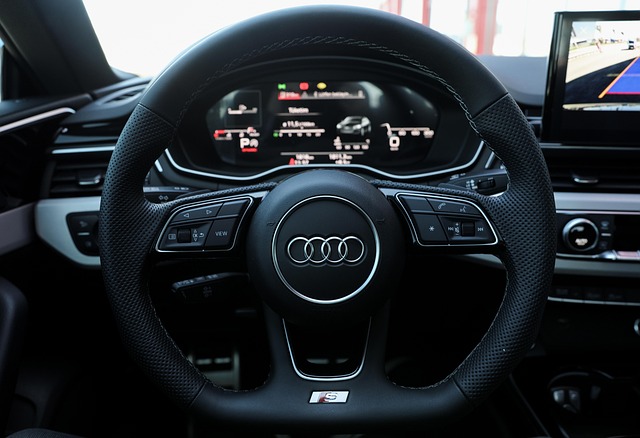Looking to register your car in California? This comprehensive guide walks you through every step, from understanding eligibility requirements to completing the application process. We’ll highlight the importance of a Vehicle Identification Number (VIN) verification at the DMV and provide insights on gathering essential documents efficiently. Whether you visit your local California DMV office or use online services, we’ve got you covered with clear instructions for a smooth registration experience.
- Understand Eligibility Requirements for Car Registration
- Gather Necessary Documents for California DMV
- Perform Vehicle Identification Number (VIN) Verification
- Visit Your Local California DMV Office or Use Online Services
- Complete Application Process and Pay Fees
Understand Eligibility Requirements for Car Registration

Before diving into the registration process, it’s crucial to understand the eligibility requirements set by the California Department of Motor Vehicles (DMV). To register your car in California, your vehicle must meet certain criteria. Firstly, it should be a legally imported or domestic model, and its odometer reading should accurately reflect its actual mileage. The DMV also conducts a Vehicle Identification Number (VIN) verification process, known as dmv vin verification, to ensure the vehicle’s authenticity and history.
Additionally, your car must have a valid safety inspection certificate, proving it complies with state safety standards. If you’re opting for a mobile vin verification or mobile vin inspection service, ensure they’re authorized by the DMV and can provide accurate, official documentation. This step is essential to avoid any legal issues during registration.
Gather Necessary Documents for California DMV

Before heading to the California Department of Motor Vehicles (DMV), ensure you have all the required documents for a smooth registration process. The DMV will need proof of ownership, typically in the form of a vehicle title or bill of sale, along with your valid driver’s license and identification documents such as a passport or state-issued ID card. Additionally, a completed DMV Form 137 (Application for Title/Registration) is mandatory.
A crucial step in preparing for registration is obtaining a Vehicle Identification Number (VIN) verification. This can be done through a mobile vin verifier or by conducting a manual inspection using the VIN decoder available on the DMV’s website. The process involves matching the vehicle’s VIN with its manufacturer’s records to ensure the car’s history is accurate and free from any discrepancies. This step is essential, especially when transferring ownership, as it helps prevent fraud and ensures compliance with California’s registration requirements.
Perform Vehicle Identification Number (VIN) Verification

Before proceeding with the registration process, it’s crucial to ensure that your vehicle’s Vehicle Identification Number (VIN) is legitimate and matches the make and model of your car. This step involves a simple dmv vin verification process, which can be done in a few different ways. One convenient method is through a mobile vin verifier app, where you simply enter your VIN and access real-time data from the manufacturer. Alternatively, you can conduct a physical vin inspection by cross-referencing the number with official records or seeking assistance from authorized personnel at a local car dealership or repair shop.
This verification step is essential to avoid any discrepancies during registration. A mobile vin verification service allows for quick and accurate confirmation, ensuring that both the vehicle’s history and specifications align. By taking this proactive measure, you can streamline the California car registration process and minimize potential delays or issues down the road.
Visit Your Local California DMV Office or Use Online Services

Visiting your local California DMV office or utilizing online services is the first step in registering your car. The Department of Motor Vehicles (DMV) provides several options for vehicle registration, including in-person visits and digital platforms. If you prefer a traditional approach, schedule an appointment at your nearest DMV to complete the registration process. Alternatively, many services are now available online, allowing you to register your vehicle from the comfort of your home or on-the-go with the help of mobile vin verification tools.
For online registration, you’ll need to provide essential information, such as your personal details and vehicle specifications. One crucial aspect is a Vehicle Identification Number (VIN) verification, which can be conveniently done through mobile vin inspection or a dedicated online service. This process ensures that your car’s details match the records, streamlining the registration experience and offering added convenience.
Complete Application Process and Pay Fees

To complete the registration process for your car in California, you’ll need to follow a straightforward application procedure and pay the associated fees. Start by gathering all the necessary documents, including proof of ownership, insurance, and identification. Then, submit an Application for Title and Registration (DMV Form 742) at your local DMV office or through their online portal.
Once your application is approved, you’ll be required to pay various fees, which may include a registration fee, a vehicle-related fee, and a title fee. You can typically pay these via cash, check, or credit card. After settling the fees, the DMV will process your request, conduct a DVV (DMV Vehicle Verification) or VIN (Vehicle Identification Number) inspection (often done through a mobile vin inspection), and issue you a registration certificate and license plates for your vehicle.
Registering a car in California involves understanding eligibility requirements, gathering essential documents, and successfully completing the application process. Performing a DMV VIN verification is a crucial step ensuring your vehicle’s authenticity. Whether you visit a local DMV office or utilize online services, each step contributes to a seamless registration experience. By following these guidelines, you’ll be well on your way to becoming a California car owner.



